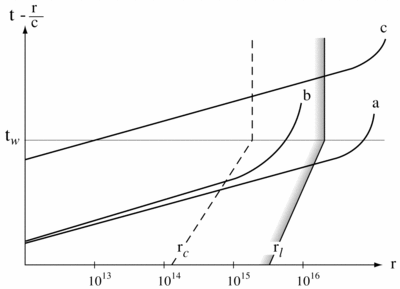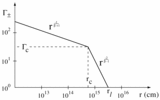Image Details

Caption: Fig. 2.
Diagram shows, for three illustrative cases, how the burst would be affected by pair enrichment. The axes (logarithmic) are r vs. ﹩t-( r/ c) ﹩, where t is time measured by a distant observer and is zero when the burst is observed to start. (In this plot, light rays are horizontal lines.) The primary gamma‐ray emission is assumed to continue, with a quasi‐steady luminosity L, for a time ﹩t_{w}﹩ (as would happen if, for instance, it came from internal shocks induced by wind variability on timescales ![]() ﹩t_{w}﹩). The criterion for runaway pair production would be satisfied within the ambient material out to a radius ﹩r_{l}﹩. (See eq. [10]; t replaces ﹩t_{w}﹩ in this equation for times ﹩t< t_{w}﹩.) The associated absorption of momentum would itself accelerate this pair‐enriched material to an r‐dependent Lorentz factor (see Fig. 1). The wind generally carries more momentum than the gamma rays and drives a relativistic blast wave that eventually sweeps up all the pair‐enriched medium. Three illustrative cases are depicted. In case a, the external medium has a low density, and the blast wave, with high η, sweeps up all the pair‐enriched medium before it has been much decelerated: the effects of the pairs are then observed primarily during the burst itself. In case b, with higher external density, deceleration occurs at radii less than ﹩r_{l}﹩, and the blast wave is still moving through pair‐enriched material during the afterglow. When the ambient medium is dense, the pairs may provide an optical depth of unity, so the primary burst itself would be reprocessed, and its short time‐structure smeared out. Case c corresponds to a lower η. The sweeping‐up of pairs then occurs during the afterglow (modifying the radiative efficiency of the outer shock) even if the external density is low and there has not (as in case b) already been deceleration.
﹩t_{w}﹩). The criterion for runaway pair production would be satisfied within the ambient material out to a radius ﹩r_{l}﹩. (See eq. [10]; t replaces ﹩t_{w}﹩ in this equation for times ﹩t< t_{w}﹩.) The associated absorption of momentum would itself accelerate this pair‐enriched material to an r‐dependent Lorentz factor (see Fig. 1). The wind generally carries more momentum than the gamma rays and drives a relativistic blast wave that eventually sweeps up all the pair‐enriched medium. Three illustrative cases are depicted. In case a, the external medium has a low density, and the blast wave, with high η, sweeps up all the pair‐enriched medium before it has been much decelerated: the effects of the pairs are then observed primarily during the burst itself. In case b, with higher external density, deceleration occurs at radii less than ﹩r_{l}﹩, and the blast wave is still moving through pair‐enriched material during the afterglow. When the ambient medium is dense, the pairs may provide an optical depth of unity, so the primary burst itself would be reprocessed, and its short time‐structure smeared out. Case c corresponds to a lower η. The sweeping‐up of pairs then occurs during the afterglow (modifying the radiative efficiency of the outer shock) even if the external density is low and there has not (as in case b) already been deceleration.
Copyright and Terms & Conditions
© 2001. The American Astronomical Society. All rights reserved. Printed in U.S.A.




